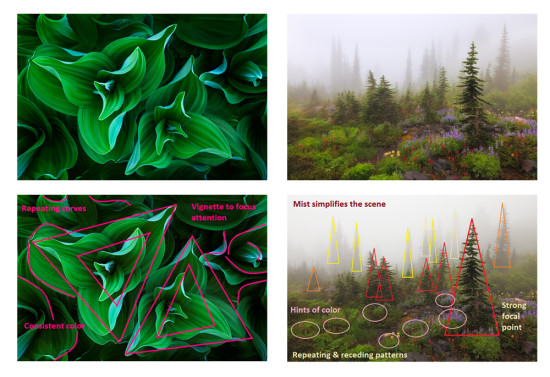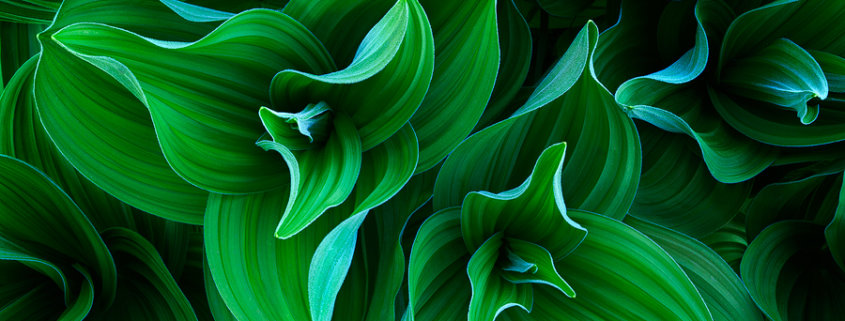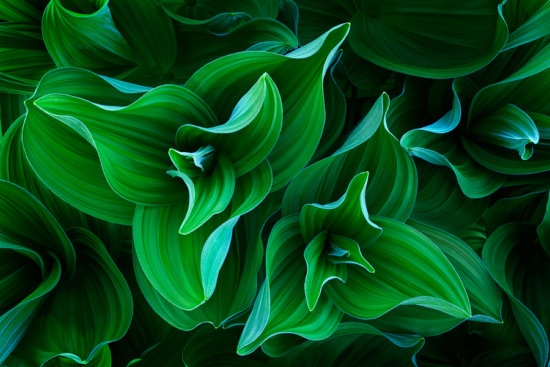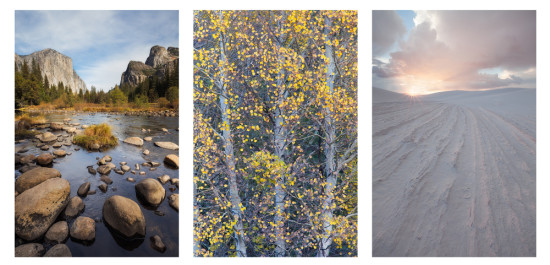Learning to See Beyond the Literal
As landscape photographers, our subjects are typically scenes made up of mountains, trees, rocks, water, clouds, and all sorts of other natural features. We craft our photographs by arranging these elements through composition. Developing the ability to see beyond the literal elements of a scene – the mountains, clouds, and other natural features – and identify the more abstract qualities is an essential skill for elevating your compositional skills.
Let’s take two sample photographs to explore the concept of going beyond the literal qualities of a scene. The literal subjects of these photographs are corn lilies on the left and trees, wildflowers, and mist on right. Now, let’s look beyond these literal subjects to identify the more abstract qualities of the scene, like shapes, lines, and repeating patterns.

Composition examples – corn lilies in Colorado and a misty day at Mount Rainier National Park. Copyright Sarah Marino.
For the photo of the corn lilies, playing off the repeating triangles helps create something more than a documentary photo of the plants. The repeating triangles, facing in opposite directions, add visual interest, with the repeating curves throughout the frame adding a feel of lusciousness and vibrancy. For the photo on the right, the composition relies on a lot of repeating shapes – triangles in the trees and ovals in the plants – with the mist helping to add depth and simplicity to the scene.
By working to identify these kinds of abstract qualities in a scene, a photographer is able to use such elements to enhance a composition, helping to elevate the resulting photograph by adding nuance and interest.
Now, take a look at the three photographs above (click here to see the photos at a larger size). The literal subject matter includes rocks, mountains, a river, aspen trees, sand dunes and clouds. Now, look beyond the literal subject matter to see if you can identify some of the more abstract qualities of each of these scenes. Think through the following concepts and see how they might apply to these three photographs and the two at the top of the post:
- Layers
- Curves
- Lines (leading, curving, radiating)
- Repetition
- Texture
- Patterns
- Shapes
In the case of the photograph of Valley View in Yosemite National Park on the left, the rocks create a curving line from the lower left to the middle right, helping draw the eye into the photograph. With the middle photograph of aspens, the white trunks create repeating straight lines throughout the frame. The leaves also add pattern and texture. The photograph of the dunes at White Sands National Monument on the right is an example of how a natural feature like hardened ridges of sand can create clear leading lines to the sunstar in the background. All of these examples demonstrate how to take literal subjects like rocks, trees, and sand ridges and turn them into abstract elements within a photographic composition.
Next time you are out photographing, take some time to study the scene and identify some abstract qualities before you get out your gear. Once you start photographing, think about how you can integrate some of those abstract qualities you identified into your resulting compositions. By spending time and being deliberate about looking beyond the literal subjects you are photographing, you can develop your ability to see the more nuanced aspects of the area you are photographing and elevate your compositional skills in the process.






That is exactly what one of my (photographer) teacher taught years ago – pleasing compositions are consisted of repeated patterns of lines, shapes, curves, color density and etc. I particularly like the corn lilies – the color version of Edward Weston’s closeup black & white photographs.